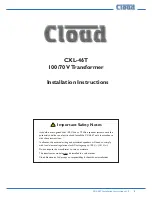
The SAF FreeMile Series Full Outdoor Unit Technical Description and Configuration Guide • Rev. 1.3
© SAF Tehnika JSC 2012
77
Figure
6.2.
Command
management
6.3
File
System
The
software
used
by
the
SAF
FreeMile
management
controller
is
organized
in
files,
which
are
stored
on
Flash
disk.
Firmware
and
boot
configuration
files
The
following
files
are
required
for
the
SAF
FreeMile
to
start:
–
‘boot.ini’
file,
‐
device
boot
configuration
file.
This
file
is
a
text
file
and
contains
the
name
of
the
firmware
file
which
must
be
executed
on
start
‐
up.
The
file
name
can
be
freely
changed,
but
its
default
name
is
‘boot.ini’;
hereinafter,
it
is
assumed
that
this
file
has
default
filename.
The
most
important
factor
concerning
this
file
is
that
it
must
be
uploaded
with
‘B’
and
‘e’
attribute
flags
(flags
are
case
sensitive!),
only
then
it
will
be
treated
as
executive
script.
Attribute
flags
for
‘boot.ini’
file:
B
–
query
run
at
boot;
e
–
executive
script
For
information
how
to
upload
files
in
the
Flash
disk,
please
refer
to
Chapter
8
.
–
Firmware
file,
‐
this
file
is
the
main
firmware
executable
for
the
appropriate
SAF
FreeMile
model.
The
file
name
can
be
freely
changed,
but
its
default
name
will
contain
the
version
and
SAF
FreeMile
model,
e.g.,
‘cfipz000.elf.ezip’.
The
most
important
factor
concerning
this
file
is
that
it
must
be
uploaded
with
‘E’
and
‘c’
attribute
flags,
otherwise
this
file
will
not
be
used
as
the
firmware.
Attribute
flags
for
firmware
file:
E
–
executable
binary;
c
‐
compressed
Notes:
–
The
files
are
uploaded
from
PC
to
Flash
disk
using
TFTP/FTP
(via
Ethernet
management
port)
For
more
information
about
file
upload
please
refer
to
Chapter
8
;
configuration
backup
files
are
created
by
SAF
FreeMile
management
system.
–
The
flash
disk
may
store
other
files
as
well,
for
example
‐
previous
firmware
versions,
configuration
backup
files,
‐
up
to
7.7
Mb
(about
8
firmware
files).
–
The
attribute
flags
for
files
are
case
sensitive.
–
The
file
names
can
be
changed,
but
it
is
very
important
that
the
file
has
the
necessary
attribute
flags;
otherwise,
the
file
will
not
be
used
either
as
firmware,
or
as
‘boot.ini’
type
file.
–
There
are
no
file
extensions
in
the
file
system;
either
file,
when
edited,
is
treated
as
ASCII
text
file.
–
When uploading the file, if the Flash disk stores the file with the same filename as for the
file being uploaded, it will be overwritten with the new file.
Additional
command
prompt
commands
Command
Description
Cls
Clears
the
screen.
Help
<command>
Provides
help
messages
for
commands.















































